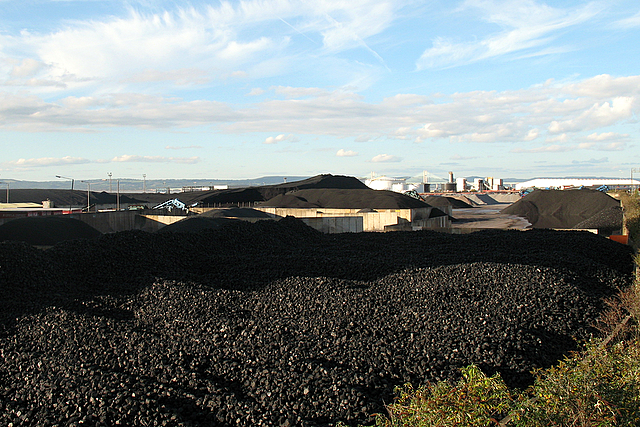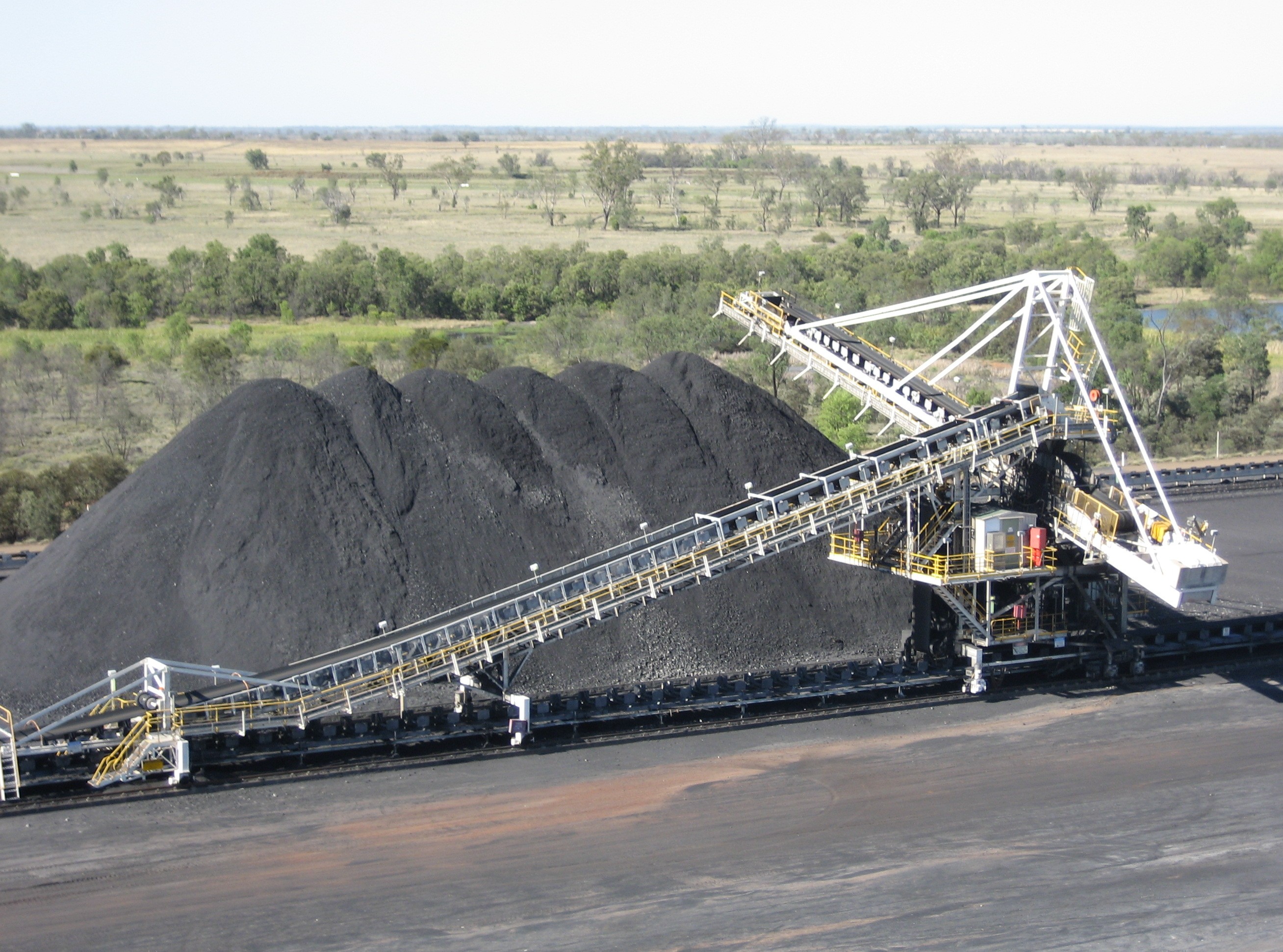Coal homogenization on:
[Wikipedia]
[Google]
[Amazon]
 Coal homogenization refers to the process of mixing
Coal homogenization refers to the process of mixing




 In a simplified form the effectiveness of the homogenization process is represented by E, the homogenization effect:
:::::E = σin / σout (where σ is the standard deviation).
In practice, varying stockpile layer thickness, type of stacking and different reclaiming methods makes the above formulae of little use. Thus, in practice the homogenization effect E is calculated as follows:
E = k , k usually varies between 0.5 and 0.7. (where n is the number of layers and k is a constant determined for each stockpiling operation)
The different types of stacking will influence k.http://www.flsmidth.com/~/media/Brochures/Brochures%20for%20crushers%20and%20raw%20material%20stores/stacker%20and%20reclaimer.ashx
In a simplified form the effectiveness of the homogenization process is represented by E, the homogenization effect:
:::::E = σin / σout (where σ is the standard deviation).
In practice, varying stockpile layer thickness, type of stacking and different reclaiming methods makes the above formulae of little use. Thus, in practice the homogenization effect E is calculated as follows:
E = k , k usually varies between 0.5 and 0.7. (where n is the number of layers and k is a constant determined for each stockpiling operation)
The different types of stacking will influence k.http://www.flsmidth.com/~/media/Brochures/Brochures%20for%20crushers%20and%20raw%20material%20stores/stacker%20and%20reclaimer.ashx
 Coal homogenization refers to the process of mixing
Coal homogenization refers to the process of mixing coal
Coal is a combustible black or brownish-black sedimentary rock, formed as rock strata called coal seams. Coal is mostly carbon with variable amounts of other elements, chiefly hydrogen, sulfur, oxygen, and nitrogen.
Coal is formed when ...
to reduce the variance of the product supplied. This homogenization process is performed during the coal stockpiling operation. Although the terms blending and homogenization are often used interchangeably, there are differences as the definitions show. The most notable difference is that blending refers to stacking coal from different sources together on one stockpile
A stockpile is a pile or storage location for bulk materials, forming part of the bulk material handling process.
Stockpiles are used in many different areas, such as in a port, refinery or manufacturing facility. The stockpile is normally cre ...
. The reclaimed heap would then typically have a weighted average
The weighted arithmetic mean is similar to an ordinary arithmetic mean (the most common type of average), except that instead of each of the data points contributing equally to the final average, some data points contribute more than others. The ...
output quality of the input sources. In contrast, homogenization focuses on reducing the variance
In probability theory and statistics, variance is the expectation of the squared deviation of a random variable from its population mean or sample mean. Variance is a measure of dispersion, meaning it is a measure of how far a set of numbe ...
of only one source. A blending operation will cause some homogenization.
Definitions
Mixing
Mixing is defined as a random rearrangement of particles by means of mechanical energy, e.g. rotary devices in a fixed volume. Traces of individual components can still be located within a small quantity of the mixed material of two or more material types. Application: small-scale storage.Blending
Blending is defined as the integration of a number of raw materials with different physical or chemical properties in time in order to create a required specification or blend. The aim is to achieve a final product from, for example, two or more coal types, that has a well-defined chemical composition in which the elements are very evenly distributed and no large pockets of one type can be identified. When sampled, the average content and thestandard deviation
In statistics, the standard deviation is a measure of the amount of variation or dispersion of a set of values. A low standard deviation indicates that the values tend to be close to the mean (also called the expected value) of the set, whil ...
from the average are the same. Application: e.g. using different types of coal for specific recipes.
Homogenizing
Homogenizing is defined as the systematic regrouping of the input flow in order to provide a more homogeneous output flow of one type of material so that inherent fluctuations of chemical or physical properties in time are evened out compared to the input flow. Application: e.g. one batch of limestone or coal, i.e. to homogenize the material in itself.
Applications
Worldwide, industry uses bulk material, like coal, as a source of energy or as a raw material for production processes. Intermediate storage facilities (for examplestockpile
A stockpile is a pile or storage location for bulk materials, forming part of the bulk material handling process.
Stockpiles are used in many different areas, such as in a port, refinery or manufacturing facility. The stockpile is normally cre ...
s) are required to decouple the (discontinuous) supply of raw materials from the (continuous) production process. Large quality fluctuations of the material properties can occur due to the geographical origin of the raw materials. This means that processes using these raw materials have to deal with these fluctuations in order to produce products with a constant quality. The fluctuations can be dealt with in two ways:
#Adapting the process, so that it can handle quality fluctuations of the raw material.
#Adapting the raw material to the requirements of the process: upgrading.
Upgrading is defined as achieving a more constant quality throughout the material flow, where the mean quality cannot be influenced, but the frequency and amplitude of fluctuations around the mean value can.
Homogenization aims to upgrade the raw material to a uniform composition of the product being homogenized. In coal homogenization the primary aim is to reduce the variance
In probability theory and statistics, variance is the expectation of the squared deviation of a random variable from its population mean or sample mean. Variance is a measure of dispersion, meaning it is a measure of how far a set of numbe ...
of the quality of the product supplied (in comparison to the variance in quality of the different sources of supply). This is necessary to ensure consistent (or homogeneous
Homogeneity and heterogeneity are concepts often used in the sciences and statistics relating to the uniformity of a substance or organism. A material or image that is homogeneous is uniform in composition or character (i.e. color, shape, siz ...
) quality, as well as a constant calorific value
The heating value (or energy value or calorific value) of a substance, usually a fuel or food (see food energy), is the amount of heat released during the combustion of a specified amount of it.
The ''calorific value'' is the total energy releas ...
of the coal.
Homogenization can be used at coal mines in order to get a better overall quality product from a stockpile. It can thus form an integral part of the quality management system in coal mines. When processing coal by more than one supplier like power station
A power station, also referred to as a power plant and sometimes generating station or generating plant, is an industrial facility for the generation of electric power. Power stations are generally connected to an electrical grid.
Many ...
s and heat plants, coal homogenization can serve well as a strategy of processing the coal in order to get to the best acceptable quality.
Coal homogenization could be applied whenever a consistent quality is needed and multiple sources of different qualities are supplied or mined.

Methods
Typically a large number of thin layers are thrown by thestacker
A stacker is a large machine used in bulk material handling. Its function is to pile bulk material such as limestone, ores and cereals on to a stockpile. A reclaimer can be used to recover the material.
Gold dredges in Alaska had a stacke ...
on a stockpile. Stacking the layers on each other ensures that the variance in input quality is reduced once the coal is reclaimed in a vertical cross section. After the coal is stacked in horizontal layers, it is reclaimed in vertical slices. When the standard deviation of each slice’s quality is determined, the resulting standard deviation is much smaller than that of the non-homogenized stockpile. 

 In a simplified form the effectiveness of the homogenization process is represented by E, the homogenization effect:
:::::E = σin / σout (where σ is the standard deviation).
In practice, varying stockpile layer thickness, type of stacking and different reclaiming methods makes the above formulae of little use. Thus, in practice the homogenization effect E is calculated as follows:
E = k , k usually varies between 0.5 and 0.7. (where n is the number of layers and k is a constant determined for each stockpiling operation)
The different types of stacking will influence k.http://www.flsmidth.com/~/media/Brochures/Brochures%20for%20crushers%20and%20raw%20material%20stores/stacker%20and%20reclaimer.ashx
In a simplified form the effectiveness of the homogenization process is represented by E, the homogenization effect:
:::::E = σin / σout (where σ is the standard deviation).
In practice, varying stockpile layer thickness, type of stacking and different reclaiming methods makes the above formulae of little use. Thus, in practice the homogenization effect E is calculated as follows:
E = k , k usually varies between 0.5 and 0.7. (where n is the number of layers and k is a constant determined for each stockpiling operation)
The different types of stacking will influence k.http://www.flsmidth.com/~/media/Brochures/Brochures%20for%20crushers%20and%20raw%20material%20stores/stacker%20and%20reclaimer.ashx
See also
* Coal Blending * Bulk material handling *Stockpile
A stockpile is a pile or storage location for bulk materials, forming part of the bulk material handling process.
Stockpiles are used in many different areas, such as in a port, refinery or manufacturing facility. The stockpile is normally cre ...
*Stacker
A stacker is a large machine used in bulk material handling. Its function is to pile bulk material such as limestone, ores and cereals on to a stockpile. A reclaimer can be used to recover the material.
Gold dredges in Alaska had a stacke ...
* Reclaimer
*Variance
In probability theory and statistics, variance is the expectation of the squared deviation of a random variable from its population mean or sample mean. Variance is a measure of dispersion, meaning it is a measure of how far a set of numbe ...
*Heat of combustion
The heating value (or energy value or calorific value) of a substance, usually a fuel or food (see food energy), is the amount of heat released during the combustion of a specified amount of it.
The ''calorific value'' is the total energy rele ...
References
{{Coal Coal Bulk material handling Mining equipment